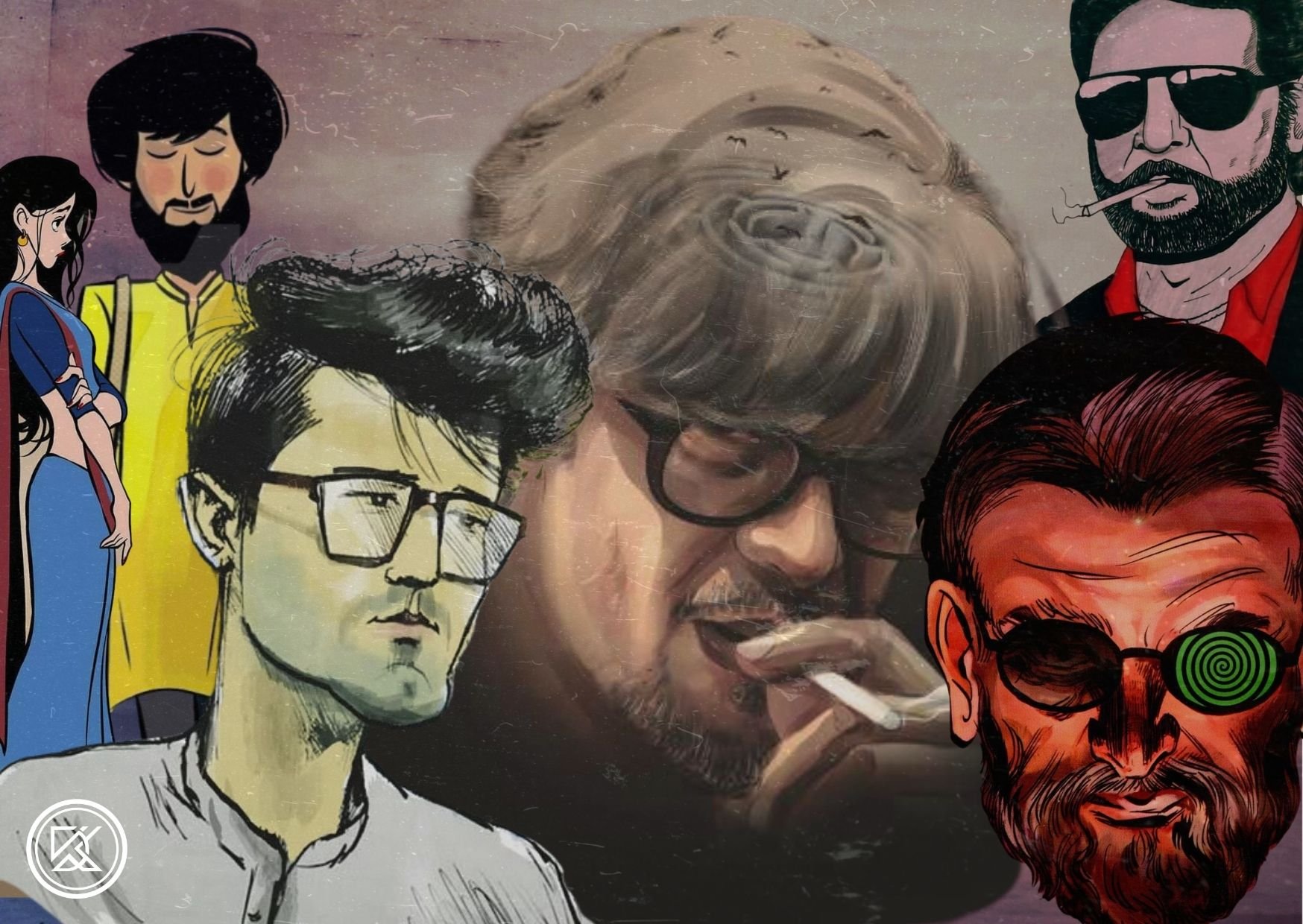Humayun Ahmed: Single-handedly Shifted the Capital of Bengali Literature from Kolkata to Dhaka
The birth of a magician
Humayun Ahmed, the renowned Bengali author, has left an indelible mark on literature enthusiasts worldwide. His versatility as a dramatist, screenwriter, filmmaker, songwriter, and scholar has earned him a place of distinction in the literary world. Born on November 13th, 1948, in Mohanganj, Netrokona, Humayun Ahmed was the eldest of five siblings. His mother, Ayesha Foyez, was a notable Bengali writer, and his younger brothers, Muhammad Zafar Iqbal and Ahsan Habib, are accomplished writers and artists in their own right. Despite his family’s frequent relocations due to his father's job as a police officer, Humayun’s creative spirit continued to flourish.
Humayun Ahmed’s academic achievements were particularly notable, as he ranked second in merit on the Rajshahi Education Board for his SSC at Bogra Zilla School in 1965. He finished his HSC at Dhaka College in 1967. He then earned his bachelor's and master's degrees in chemistry from Dhaka University and later completed his Ph.D. in polymer chemistry at North Dakota University, USA. After completing his studies, he returned to Bangladesh and taught at Dhaka University until 1990.
Humayun Ahmed’s contributions to Bengali literature are significant, with his novels, short stories, and plays captivating audiences worldwide. His literary style is marked by a deep understanding of human nature and a keen observation of society. His work has been translated into many languages and continues to inspire and engage readers of all ages. His legacy as one of the most prominent literary figures of our time remains intact, and his influence on Bengali literature will continue to be felt for generations to come.
From a writer to a filmmaker: An immortal journey
During Bangladesh’s liberation war in 1971, Humayun Ahmed, a student at Dhaka University, was busy writing his first novel, “Nondito Noroke: In Blissful Hell” Despite the chaos and turmoil of war, the novel was published in 1972 with the help of famous writer Ahmed Sofa and the Khan Brothers’ Publication. This marked the beginning of Humayun Ahmed's illustrious writing career, with numerous bestselling novels following in the years to come.
Throughout his literary career, Humayun Ahmed has produced a wealth of notable works that have earned him widespread recognition and acclaim. Some of his best-known books include “Shonkhonil Karagar,” published in 1973, “Aguner Poroshmoni,” published in 1986, and “Bohubrihi,” published in 1990. He also wrote “Dorjar Opashe” in 1992, “Megher Chaya” in 1993, “1971: A Novel,” “Nabani,” and “Tomake” in 1994, “Kobi” in 1996, “Opekkha” in 1997, “Megh Boleche Jabo Jabo” and “Tomader Ei Nogore” in 2000, “Dwitiyo Manob” in 2002, “Jochona O Jananir Golpo” in 2004, “Madhyanna” in 2007, and “Ami” in 2011.
Humayun Ahmed was also the mastermind behind beloved characters such as Misir Ali, Himu, and Shuvro, who are featured in the “Himu Somogro” and “Misir Ali Somogro” series, each with 23 and 20 novels, respectively, and the “Shuvro Somogro” series, which has six novels. Each of his characters is unique and inimitable, existing in their own world and being incomparable with one another.
Humayun Ahmed was a trailblazing artist, whose talents spanned across multiple art forms, including drama and film. His work as a director and dramatist has left an indelible mark on the cultural landscape of Bangladesh. Humayun Ahmed directed several iconic TV shows and dramas, including the widely popular Bohubrihi (1988), Kothao Keu Nei (1990), Nokkhotrer Raat (1994–1955), Aaj Robibar (1996–1999), and Urey Jai Bok Pokkhi (2004–2005). These productions caused a sensation among audiences during their airtime, with the final episode of Kothao Keu Nei leading to widespread protests following the death of Baker Bhai, portrayed by the legendary actor Asaduzzaman Nur.
The filmography of Humayun Ahmed is equally impressive, with a range of popular titles such as Shonkhonil Karagar (1992), Aguner Poroshmoni (1994), Srabon Megher Din (2002), Dui Duari (2001), Nondito Noroke (2006), Daruchini Dip (2007), Amar Ache Jol (2008), and Ghetu Putro Komola (2012). These productions have captured the hearts and minds of audiences of all ages, cementing Humayun Ahmed’s position as a significant contributor to Bangladeshi film and television history.
How did Humayun Ahmed shift the capital of Bengali literature from Kolkata to Dhaka?
Humayun Ahmed, an iconic figure in Bengali literature, was responsible for a revolution that shifted the capital of Bengali literature from Kolkata to Dhaka. Through his literary works, he introduced a new cultural identity, one that incorporated unique fashion and food elements distinct from those depicted in the works of famous writers such as Rabindranath Tagore, Bibhutibhushan Bandopadhyay, and Manik Bandopadhyay, who used Bengali as a holy language in their writing.
The writing style of Humayun Ahmed was different from the traditional style of Kolkata writers. He employed the local and colloquial language of Bangladesh, which drew a wider audience, especially among Bengali literature lovers and Bangladeshi readers. His male characters sported loose shirts and pants, while female characters donned sarees with half-sleeve blouses and side-parted braids. The food culture depicted in his novels was also distinctive, showcasing Bangladeshi cuisine with popular dishes like polao, chicken roast, mutton rezala, and beef korma.
With his unique approach, Humayun Ahmed effectively shifted the center of Bengali literature from Kolkata to Dhaka. He left behind a lasting legacy as a prominent writer in Bangla literature, an achievement that will never be forgotten. Humayun Ahmed’s contribution to Bangla literature has cemented his place as a cultural icon and a pioneer in the field of Bengali literature.
The unforgettable characters of Humayun Ahmed: Misir Ali, Himu, Baker Bhai, and Shuvro
Humayun Ahmed was a master storyteller who crafted unforgettable characters such as Misir Ali, Himu, Baker Bhai, and Shuvro. Despite having created many other memorable characters, these four have gained the most popularity and recognition.
Misir Ali
Humayun Ahmed crafted one of the most entertaining characters in Bengali literature, Misir Ali. Over the past three decades, Misir Ali has become a household name and a beloved figure in the literary world. A part-time psychology professor at the University of Dhaka, Misir Ali is tall, dark, and thin with an impressive reputation as a psychiatrist. People come to him for psychiatric treatment because of his expertise in parapsychology. With a wise and logical approach, Misir Ali meticulously examines every letter he receives, reading it three times before solving the parapsychological mysteries presented to him. Despite his work in this field, Misir Ali is a rationalist who does not believe in paranormal activities. He maintains a personal diary named “Unsolved,” where he documents all the mysterious cases that remain unresolved. The first story in the Misir Ali series, “Debi,” was adapted into a movie in 2018, titled “Debi: Misir Ali Prothombar,” with Chanchal Chowdhury taking on the role of Misir Ali.
Himu
Himu, a creation of the renowned author Humayun Ahmed, has become a sensation among young people, particularly university students. With the full name of Himaloy, Himu embodies a bohemian lifestyle as instructed by his father. He can be spotted walking the streets of Dhaka in a distinctive yellow panjabi and barefoot, with no particular destination in mind. Despite living a life as a beggar with no means of income, Himu exists in his own world where logic holds no influence. He has gained a large following for his spiritual powers of foretelling the future, even though he sometimes delivers unpleasant truths. Himu embodies the alluring and enigmatic sides of life. His first appearance was in the novel “Moyurakkhi.”
Baker Bhai
Baker Bhai, a local gangster with two accomplices, Bodi and Mojnu, gained notoriety through his portrayal in the popular TV series “Kothao Keu Nei,” which aired on Bangladesh Television from 1993 to 1994. Despite his criminal reputation, Baker Bhai is known for his sense of fairness and individuality. This character was originally introduced in the 1992 novel of the same name by Humayun Ahmed. In the story, Baker Bhai falls for a girl named Muna, who initially has no respect for him. However, as the story progresses, she develops feelings for him. Sadly, Baker Bhai meets his end when he is betrayed by a friend and falsely accused of murder, resulting in his execution. Asaduzzaman Nur brought the character of Baker Bhai to life in the TV adaptation.
Shuvro
Shuvro first made his debut in Humayun Ahmed’s short story, “Ekti Shada Gari.” The character quickly gained popularity, and Humayun Ahmed went on to write six novels featuring Shuvro from 1990 to 2010. In 2007, the novel “Daruchini Dip” was adapted into a movie with Riaz as Shuvro. This fictional character is seen as a symbol of perfection with a pure spirit. Shuvro is idolized by Bengali readers, who see him as a beautiful prince with thick-rimmed glasses and a kind heart. Although he may not be as well known as Humayun Ahmed's other characters like Misir Ali or Himu, Shuvro still holds a special place in the hearts of readers.
The popularity of Humayun Ahmed’s characters can be attributed to his ability to captivate the hearts of his readers. Despite being fictional, these characters are adored by Bengali literature enthusiasts. Every year, a significant number of books by Humayun Ahmed are sold, with both old and new readers alike drawn to his novels. It is evident that his fictional characters play a vital role in shifting the center of Bengali literature from Kolkata to Dhaka.
The unimaginable farewell
The unimaginable farewell... It still feels like a nightmare. Humayun Ahmed, a cherished figure in Bangladesh, will always hold a special place in our hearts. We still cannot fathom that he is no longer with us. The literary genius, despite battling cancer, kept writing until his last breath. But on that fateful day, July 19, 2012, in New York City, he left us all, leaving an unfillable void in the literary world.
The legacy of Humayun Ahmed as a prominent author in Bangla literature is unmatched by anyone who came after. His works touched the hearts of millions, and his presence was larger than life. His novels, dramas, and movies were a reflection of his creative genius, and his storytelling was unparalleled. He had an innate ability to craft characters who touched our hearts and minds and stayed with us long after we finished reading.
Today, we continue to remember Humayun Ahmed with reverence and admiration. His numerous masterpieces solidify his place as an exceptional writer, one who can never be replaced. We still read his books, watch his dramas, and remember his wisdom. The way he wrote about love, life, and what it means to be human still has a big effect on us.
Despite his departure, his memory lives on, and his legacy will continue to inspire generations to come. We will forever be grateful for the gift of his words and the stories he shared with us. Rest in peace, our beloved writer. You will be missed, but never forgotten.



























